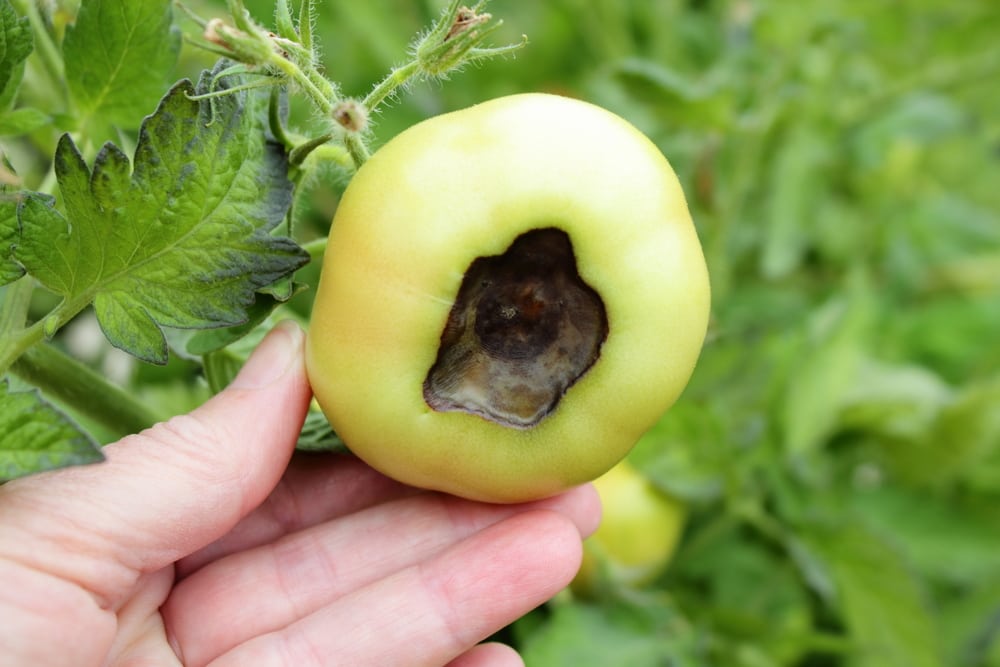Lawn & Garden

Blossom-end rot is a physiological disorder or an abiotic disease (caused by drought, freezing, and other stressors). It is not a disease caused by fungi, bacteria, or other pathogens.
Blossom-end rot is easily identified as a brown, leathery rot developing on or near the blossom end of the tomato. It starts with a dry, brown lesion the size of a dime and generally increases in diameter as the condition worsens. In time, lesions often become covered with a secondary black mold. There is also a condition called internal blossom-end rot in which symptoms develop on the sides of the fruit or internally. You might not see the damage until you cut into the fruit.
Causes of BER
BER is caused by a calcium deficiency, usually induced by fluctuations in a plant’s water supply. Because calcium is not a “mobile” element in plants, even brief changes in the water supply can cause BER.
Droughty soil or damage to the roots from excessive or improper cultivation (severe root pruning) can restrict water intake, thus preventing plants from getting the calcium they need. Plants also can develop calcium deficiency and BER if they are growing in highly acidic soil or are getting too much water from heavy rain, overirrigation, or high relative humidity.
Preventing BER
The methods used to manage BER in tomatoes are equally effective for other susceptible crops, such as peppers, eggplants, cucumbers, and watermelons. To manage BER, take the following steps:
- Keep the soil’s pH at 6.0 to 6.5. Perform a soil test and apply the recommended rate of lime (use dolomitic or high-calcium limestone). Apply and incorporate lime 2 to 4 months before planting tomatoes.
- Apply the required amount of fertilizer when necessary based on soil test results. Applying too much fertilizer at one time can actually induce BER.
The most accurate way to fertilize properly is to follow soil test recommendations.
- Apply mulch to conserve moisture. Use pine straw, straw, decomposed sawdust, or newspaper. Mulches conserve soil moisture and reduce the incidence of BER.
- Give your plants adequate water. Tomato plants need about 11⁄2 inches of water per week during fruiting. Extreme fluctuations in soil moisture can result in greater incidences of BER.
- If your plants develop BER, drench the soil around their roots with a calcium solution containing 4 pounds of calcium nitrate or calcium chloride per 100 gallons of water (or 4 level tablespoons per gallon of water). Spraying the plants with calcium has no effect on BER.
- Some tomato varieties, especially many heirlooms, tend to be more sensitive to conditions that cause BER. Try growing several varieties and keep notes as to their performance.
- If you see fruit with BER, you should remove the affected fruit. Once a fruit develops BER, it will not regrow or repair the infected area. Remove the fruit; otherwise, the damaged area will serve as an entry point for disease-causing bacteria or fungi.
 Joseph Kemble, Extension Vegetable Specialist and Horticulture Professor; Edward Sikora, Extension Plant Pathologist and Entomology and Plant Pathology Professor, both at Auburn University
Joseph Kemble, Extension Vegetable Specialist and Horticulture Professor; Edward Sikora, Extension Plant Pathologist and Entomology and Plant Pathology Professor, both at Auburn University
Revised July 2020, Blossom-End Rot in Tomatoes: Causes and Prevention, ANR-1059

